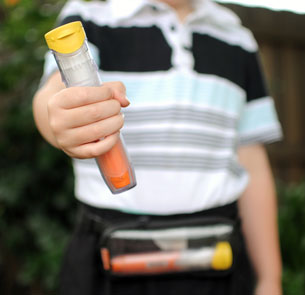
According to the Asthma and Allergy Foundation, “peanuts are the most common allergen followed by milk and shellfish.” With a peanut allergy being so prevalent in America, it’s important to understand the basics.
What is a peanut allergy?
A peanut allergy is not something to take lightly. When someone has a peanut allergy, their body incorrectly identifies peanuts as a harmful foreign substance. The immune system, usually targeting diseases and infections, then goes into defense mode, reacting to the peanut and causing a serious response in most people.
Affecting different tissues in the body such as skin, nose, eyes, lungs, blood vessels and more, the immune system releases chemicals into your blood causing the allergic reaction. The underlying cause of the immune system’s reaction to peanuts is not known.
What are the symptoms of a peanut allergy?
Peanut allergies and the symptoms associated range from mild to extremely severe. Mild symptoms of a peanut allergy include tingling in the lips or tongue, hives, itchy eyes, runny nose, or aching stomach. These mild symptoms can start within minutes up to several hours after consuming peanuts or something with peanuts in it.
A severe peanut allergy comes with more health risks if exposed to peanuts or something with peanuts in it. A reaction called anaphylaxis can occur if severely allergic to peanuts causing:
- Dizziness
- Issues swallowing or breathing
- Loss of consciousness
- Low blood pressure
- Swelling of the lips, tongue, or throat
- Vomiting and diarrhea
Anaphylaxis usually starts within minutes of consumption, but can take several hours to occur. If anaphylaxis is left untreated, it can be fatal.
How do I know I have a peanut allergy?
Starting with differentiating a peanut allergy from an intolerance to the food, you doctor will obtain a personal and family medical history, ask about the symptoms to the reaction and if anyone else had symptoms, and consult with you about further testing needs.
To confirm the peanut allergy, an allergy skin test is performed. The test is pain-free and requires no shots. A small amount of allergen is pressed on the skin and within approximately fifteen minutes it’s clear whether or not the peanut allergy is prevalent. If allergic, the skin will become red, raised, or itchy.
How are peanut allergies treated?
For mild allergic reactions, it’s possible taking an antihistamine or diphenhydramine will be adequate enough to reduce the symptoms of the peanut allergy’s reaction. For severe reactions, a person going into or experiencing anaphylaxis should be shot with epinephrine. After administering the shot, it’s important to be monitored at a hospital even if your symptoms have subsided.
If you do not have epinephrine, call 911 if you are having a severe allergic reaction.
During an appointment at Langford Allergy, you can expect to meet with Dr. Langford himself and he will be sure to answer any questions you might have. Langford Allergy is a physician-driven practice, which means that Dr. Langford knows every patient personally and seeks to implement a superior standard of care.
Call Langford Allergy at 478-787-4728 to schedule a peanut allergy testing appointment.
